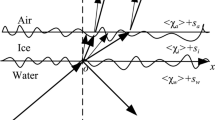Abstract
Owing to the multipath effect, the source localization in shallow water has been an area of active interest. However, most methods for source localization in shallow water are sensitive to the assumed model of the underwater environment and have poor robustness against the underwater channel uncertainty, which limit their further application in practical engineering. In this paper, a new method of source localization in shallow water, based on vector optimization concept, is described, which is highly robust against environmental factors affecting the localization, such as the channel depth, the bottom reflection coefficients, and so on. Through constructing the uncertainty set of the source vector errors and extracting the multi-path sound rays from the sea surface and bottom, the proposed method can accurately localize one or more sources in shallow water dominated by multipath propagation. It turns out that the natural formulation of our approach involves minimization of two quadratic functions subject to infinitely many nonconvex quadratic constraints. It shows that this problem (originally intractable) can be reformulated in a convex form as the so-called second-order cone program (SOCP) and solved efficiently by using the well-established interior point method, such as the software tool, SeDuMi. Computer simulations show better performance of the proposed method as compared with existing algorithms and establish a theoretical foundation for the practical engineering application.
Similar content being viewed by others
References
Baggeroer, A. B., Kuperman, W. A. and Mikhalevsky, P. N., 1993. An overview of matched field method in ocean acoustics, IEEE J. Oceanic Eng., 18(4): 401–424.
Hou, Y. S., Huang, J. G., Zhang, L. J. and Jin, Y., 2008. A novel bearing estimation method for shallow water targets, Journal of Xi’an Jiaotong University, 42(10): 1295–1299. (in Chinese)
Hu, Z. G. and Hua, X. H., 2010. Deriving Tikhonov parameter using optimal regularization method, Science of Surveying and Mapping, 35(2): 51–53. (in Chinese)
Krim, H. and Viberg, M., 1996. Two decades of array signal processing research, IEEE Signal Proc. Mag., 13(4): 67–94.
Lakshmipathi, S. and Anand, G. V., 2004. Subspace intersection method of high-resolution bearing estimation in shallow ocean, Signal Processing, 84(8): 1367–1384.
Lee, N., Zurk, L. M. and Ward, J., 1999. Evaluation of reduced-rank, adaptive matched field processing algorithms for passive sonar detection in shallow water environment, Proc. IEEE Ocean’99, 34, 876–880.
Seong, W. and Byun, S. H., 2002. Robust matched field-processing algorithm based on feature extraction, IEEE J. Oceanic Eng., 27(3): 642–652.
Snellen, M. and Simons, D. G.., 2001. An evaluation of the accuracy of shallow water matched field inversion results, J. Acoust. Soc. Am., 109(2): 514–527.
Song, H. Y., Piao, S. C. and Qin, J. P., 2012. Performance analysis of robust adaptive beamforming based on vector optimization, Acta Electronica Sinica, 40(7): 1351–1357. (in Chinese)
Sturm, J. F., 1999. Using SeDuMi 1.02, a MATLAB toolbox for optimization over symmetric cones, Optimization Methods and Software, 11(1): 625–653.
Vorobyov, S. A., Gershman, A. B. and Luo, Z. Q., 2003. Robust adaptive beamforming using worst-case performance optimization: A solution to the signal mismatch problem, IEEE T. Signal Proces., 51(2): 313–324.
Zhang, A. M., Lin, J. and Huang, X. D., 2006. Least square approach for subspace intersection method of bearing estimation in shallow water, Journal of Harbin Engineering University, 27(1): 1–4. (in Chinese)
Author information
Authors and Affiliations
Corresponding author
Additional information
This Project supported by the Specialized Research Fund for the Doctoral Program of Higher Education of China (Grant No. 20122304120011) and the Fundamental Research Funds for the Central Universities of Ministry of Education of China (Grant No. HEUCFR1119).
Rights and permissions
About this article
Cite this article
Song, Hy., Shi, J. & Liu, Bs. Robust source localization in shallow water based on vector optimization. China Ocean Eng 27, 379–390 (2013). https://doi.org/10.1007/s13344-013-0033-9
Received:
Revised:
Accepted:
Published:
Issue Date:
DOI: https://doi.org/10.1007/s13344-013-0033-9




